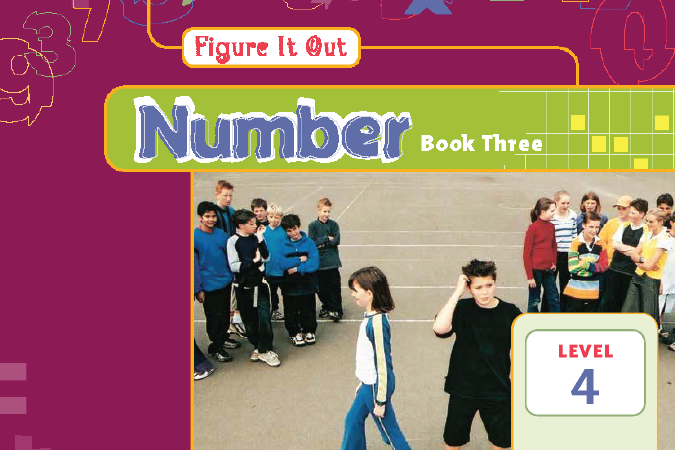Exploration to Earth
This is a level 3 number link activity from the Figure It Out series. It is focused on ordering large numbers, as well as adding and subtracting large numbers using rounding to estimate. A PDF of the student activity is included.

About this resource
Figure It Out is a series of 80 books published between 1999 and 2009 to support teaching and learning in New Zealand classrooms.
This resource provides the teachers' notes and answers for one activity from the Figure It Out series. A printable PDF of the student activity can be downloaded from the materials that come with this resource.
Specific learning outcomes:
- Order large numbers.
- Add and subtract large numbers using rounding to estimate.
Exploration to Earth
Achievement objectives
NA4-1: Use a range of multiplicative strategies when operating on whole numbers.
NA3-1: Use a range of additive and simple multiplicative strategies with whole numbers, fractions, decimals, and percentages.
NA3-4: Know how many tenths, tens, hundreds, and thousands are in whole numbers.
Required materials
- Figure It Out, Link, Theme: Number, Book Three, "Exploration to Earth", page 22
- a calculator (optional)
See Materials that come with this resource to download:
- Exploration to Earth activity (.pdf)
Activity
In this activity, the students use and think about large numbers. Their use of the space line for question 1a will reveal how well the students understand large numbers.
Having them place the numbers they know, such as 100 000, 200 000, and 300 000, onto the space line first may help them to figure out the other numbers. The question asks only for the approximate position on the space line for each distance. Having the students explain why they placed a space stop where they did would reveal the depth of their understanding.
Question 1b requires the students to subtract the distance from each space station from 1 000 000. To help the students to fully develop an understanding for large numbers and addition and subtraction, you could have them use at least three different methods of working these distances out. Here are several methods that they could use:
Earth to Hilf is 500 000 kz.
Method: Using already known knowledge, that is, half of a million is 500 000
Earth to Anzax is 188 000 kz.
Method: Mental calculations, using adding on
812 thousand + 100 thousand is 912 thousand.
912 thousand + 80 thousand is 992 thousand.
992 thousand + 8 thousand is 1 000 thousand.
Therefore, the answer is 100 + 80 + 8 thousand or 188 000.
Earth to Kleenax is 750 962 kz.
Method: Mental calculations, working to simpler numbers
249 038 + [something] = 250 000 38 + [962] = 1 000
250 000 + [something] = 1 000 000 250 000 + [750 000] = 1 000 000
Therefore, the answer is 962 + 750 000 or 750 962.
Earth to Relax is 664 856 kz.
Method: Calculator
1 000 000 – 335 144 = 664 856
1.
a. A space line might look like this:

b. Taking each distance from Zozax away from 1 000 000 gives the distance of each space stop from Earth:
- Anzax 188 000 kz
- Cojax 359 250 kz
- Exax 391 014 kz
- Gotax 916 743 kz
- Kleenax 750 962 kz
- Havax 506 975 kz
- Minax 826 531 kz
- Relax 664 856 kz
- Hilf 500 000 kz
2.
a. The distances between space stops are:
- Zozax–Gotax: 83 257 kz
- Gotax–Minax: 90 212 kz
- Minax–Kleenax: 75 569 kz
- Kleenax–Relax: 86 106 kz
- Relax–Havax: 157 881 kz
- Havax–Hilf: 6 975 kz
- Hilf–Exax: 108 986 kz
- Exax–Cojax: 31 764 kz
- Cojax–Anzax: 171 250 kz
- Anzax–Earth: 188 000 kz
b. The number of sleeps can be worked out by finding how many 25 000 kz fit into the distance from one space stop to the next. (Any part distance would mean a sleep or a break at the next space stop.)
- Zozax–Gotax: 3 sleeps (83 257 kz)
- Gotax–Minax: 3 sleeps (90 212 kz)
- Minax–Kleenax: 3 sleeps (75 569 kz)
- Kleenax–Relax: 3 sleeps (86 106 kz)
- Relax–Havax 6 sleeps (157 881 kz)
- Havaz–Hilf: 0 sleeps (6 975 kz)
- Hilf–Exax: 4 sleeps (108 986 kz)
- Exax–Cojax: 1 sleep (31 764 kz)
- Cojax–Anzax: 6 sleeps (171 250 kz)
- Anzax–Earth: 7 sleeps (188 000 kz)
3.
Minax, Relax, Hilf, Cojax, and Anzax.
The quality of the images on this page may vary depending on the device you are using.


